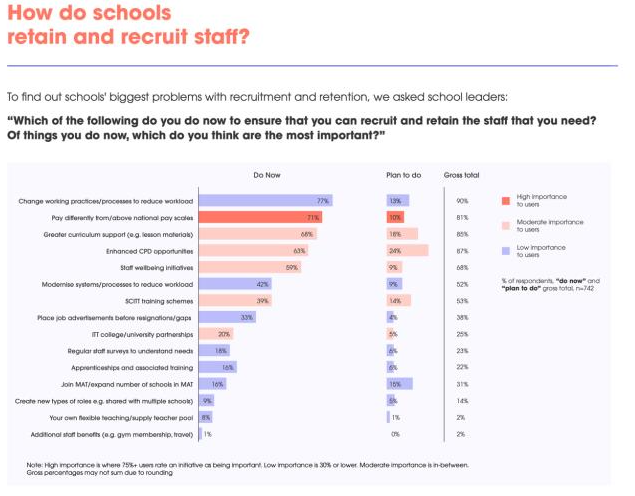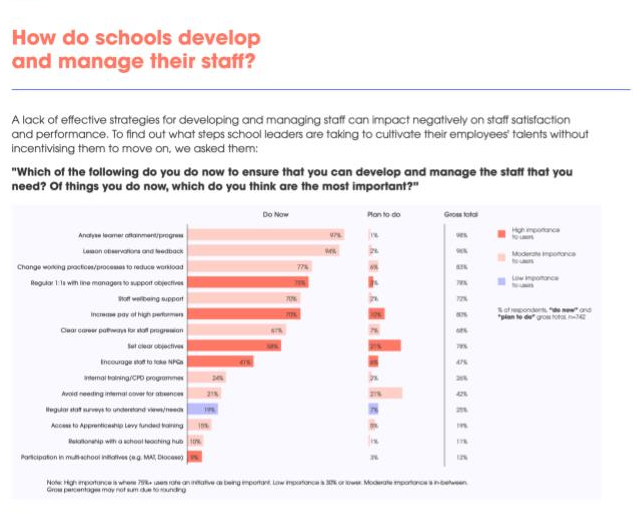
Schools are under strain from a potent mix of pressures, including tightening budgets, workload, recruitment and retention and industrial action.
The Chancellor’s announcement of extra funding for schools in November’s budget statement was certainly welcome, although the impact of this money is likely to be reduced by further energy cost increases and staff pay rises.
With times unpredictable and unstable, training and development organisation Best Practice Network, in conjunction with Supporting Education Group (SEG), carried out a large-scale survey to ask leaders in England’s schools about how they are managing one of the key high-pressure areas: workforce.
We received responses from 742 leaders from a range of different backgrounds, school types, sizes, geographical regions and Ofsted ratings.
And their responses shed some light on the staffing challenges faced by schools and how they are choosing to tackle them, indicating the increasing role strategies such as enhanced CPD, staff wellbeing and curriculum support are likely to play in the future for school leaders.
Recruitment and retention
Our research showed that recruitment stands out as a schools’ biggest headache, ranked by almost half of respondents as their top staffing difficulty.
Retaining staff also features prominently in their list of challenges, mentioned as a top-two concern by 79% of respondents.
By contrast, managing staff is seen as a more manageable aspect of staffing, ranked fourth by 55% of school leaders. Likewise, development is seen as a mid-tier difficulty.
It should, nonetheless, be noted that schools don’t feel staffing challenges equally – whilst approximately 80% of schools find recruitment and retention the most challenging aspect of staffing, more than 20% find developing and managing their staff most challenging.
To find out schools’ biggest problems with recruitment and retention, we asked school leaders: “Which of the following do you do now to ensure that you can recruit and retain the staff that you need? Of things you do now, which do you think are the most important?”
Graphic 1:

The 2019 DfE Workload Survey found that most school staff view their workloads as unacceptable. It’s therefore unsurprising that changing working practices to reduce workload is used by 90% of school leaders surveyed.
Another such change to reduce workload is to modernise their systems. However, both are seen as less important measures.
Pay is the lever that school leaders regard as most important for recruitment and retention. 77% are currently paying differently to the national scale, and 10% plan to do so. Given that school budgets are set to get tighter, this will become a more challenging lever to deploy.
Enhanced CPD and staff wellbeing initiatives are used by 63% and 59% of schools respectively, and seen as moderately important. Almost a quarter (24%) of schools are planning to introduce more training for staff in the next two years, upon which it will become the second most-used strategy.
SCITT training is both moderately popular and considered moderately important. However, partnerships with ITT universities or colleges are only used by a minority of schools (20%).
Apprenticeship training is also underused at present as a recruitment method, used by just 16% of schools. However, with 6% of schools planning to train apprentices in the next two years, the likelihood is that this will change.
Developing and managing staff
A lack of effective strategies for developing and managing staff can have a negative impact on staff satisfaction and performance. To find out what steps school leaders are taking to cultivate their employees’ talents without incentivising them to move on, we asked them: “Which of the following do you do now to ensure that you can develop and manage the staff that you need?” and “Of things you do now, which do you think are the most important?”
The most-used tools to develop and manage staff are analysing learner progression data (97% of schools) and lesson observations (94%)
While both are used heavily, neither is seen as more than moderately important. This tallies with our conversations with teachers, who do not generally regard either as a “supportive” measure.
Graphic 2:

A significant majority of schools – between 60 and 80% – are using more straightforward measures like changing working practices to reduce workload, setting clear development pathways and providing staff wellbeing support.
While popular, these measures are only regarded as moderately important.
One to one meetings with line managers, increasing high performers’ pay and setting clear objectives all marry high rates of use with high perceived importance. As these HR practices are commonly used across all sectors, it is unsurprising that their use in schools is set to see double-digit growth.
Our survey also revealed that 42% of schools are either avoiding or looking to avoid the use of internal cover. This will most likely involve the use of temporary staff.
Regional variations
The survey also revealed that schools struggle slightly more with recruitment in the North West and South West (84% and 80% of school leaders find recruiting staff most challenging), than in London (74%).
Although the contrasts between school types is not very significant it is worth noting some nuances. For example, secondary schools and academies find managing staff slightly more challenging than primary schools and LA maintained schools. This may reflect the challenges associated with their greater size and complexity.
Conclusion
While pay continues to be regarded as a key measure schools can use to improve recruitment and retention, this will become a more challenging lever to deploy as school budgets get tighter. This explains the increasing role strategies such as enhanced CPD, staff wellbeing and curriculum support are likely to play in the future for school leaders.
PANEL 1
At a glance: Key findings from Best Practice Network’s talent survey
- Schools differ in the areas they find most challenging – while 80% of school leaders struggle most with recruiting and retaining staff, 20% struggle most with developing and managing them – and in the strategies they employ to deal with those challenges
- Teacher pay is a key lever for tackling talent challenges. Schools plan on using this strategy more which will be a struggle in the context of falling enrolment numbers in primary schools and the current economic climate
- CPD is expected to be the second most used strategy for recruitment and retention in two years’ time
- Staff training in various forms (particularly SCITT and NPQs, but also ITT partnerships and apprenticeships) are expected to grow
- Tools to manage and develop staff that would ordinarily be widespread good practice for most commercial organisations have relatively low penetration in schools despite their importance to users. We expect uptake to increase in the future.
Will Rogers is Programme Director for the National Professional Qualifications (NPQs) at Best Practice Network, one of the UK’s leading providers of training, development and support for education professionals. For further information about the qualifications on offer please go to www.bestpracticenet.co.uk
PANEL 2
Insights into safeguarding practice
Perceptions of the effectiveness of various aspects of safeguarding practice was the subject of a major survey by UK school support business, Judicium Education, writes Helen King.
School leaders and designated safeguarding leads see several key safeguarding areas as relatively ineffective and highly challenging according to the survey of more than 620 designated safeguarding leads (DSLs) and SLT members in schools across England, carried out in partnership with Supporting Education Group.
The survey asked to rate the effectiveness of a range of key safeguarding activities.
Schools found that filtering and monitoring ICT usage, along with safeguarding training and updating safeguarding records to be areas of low effectiveness and high personal challenge.
Just 18% of all respondents said filtering and monitoring was as effective as it can be in their schools, with 59% claiming it is one of their biggest current challenges. These results were driven by DSLs – 65% rated it a big challenge, compared to 46% of SLTs.
Just a quarter (25%) of all respondents thought that their current safeguarding and child protection training works well and 43% said the activity is one of their biggest challenges. DSLs once again led these concerns – just 16% find this training works as well as it could, compared to 49% of SLT members.
Updating and reviewing safeguarding records to identify patterns of events or behaviour was another key pain point for effective safeguarding, with 30% finding this activity challenging.
Drafting and reviewing policies, and communicating with stakeholders, such as other professionals, parents, students and agencies, were rated as high effectiveness, low challenge activities.
The aim of the survey was to better understand how schools think about and meet some of the challenges associated with safeguarding and to explore if any additional resources and support can be provided to help schools with this important area.
The findings follow analysis by Judicium which has revealed the important part safeguarding failures play in Ofsted category 4 inspection reports.
Of the 130 inadequate judgements between 2019 and 2021, 59 (45%) cited safeguarding as ineffective. Record keeping, leadership, and governance, following-up concerns, staff training and pupil safety were most frequently cited in inspector feedback in these cases.
We know from our safeguarding work with schools that the risks of getting safeguarding wrong are significant and can have a devastating impact on pupils. These findings will help to highlight key areas of concern for schools, service providers and policy makers.
We also need to bear in mind that the DSL role is a high accountability job which has grown hugely in recent years – KCSIE has more than trebled in size over the past seven years, from 57 pages in 2015 to almost 180 today. That needs to be reflected in the understanding of the DSL remit and the support that is available to them if the role is to remain effective.
Helen King was a DSL in a London secondary school and is now head of safeguarding at Judicium, offering safeguarding expertise to schools
Register for free
No Credit Card required
- Register for free
- Free TeachingTimes Report every month